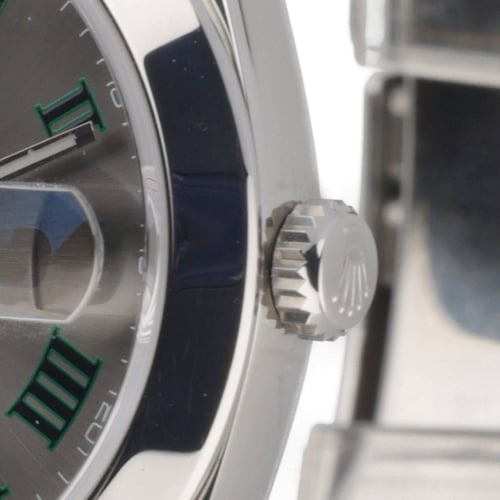Occasionally, you may need to wind your Rolex watch. Winding your Rolex will ensure the timekeeping is precise and that your watch is functioning the way it should. Winding your Rolex is actually a fairly simple process once you know the steps. But, if you’ve never wound one before, it can be a bit intimidating. It’s understandable that you want to be careful with your luxury timepiece. Fortunately, Rolex has made it intuitive and convenient to wind your watch with their ingenious engineering.
In today’s BQ Watches blog, we’ll explain how to wind your Rolex. Read on and follow our step-by-step guide!
What Rolex Watches Require Winding?
Most Rolexes will require winding in some way or another. Some will need winding more often while others will hardly need any winding at all. The two different movements are manual and automatic. If you have an automatic watch, things will be a little easier.
Let’s take a look at both options:
Manual Winding Watches
Modern Rolex watches will likely have an automatic movement, but the older vintage models will require manual winding. Manual winding is fairly simple, but if you want your watch to work the way it’s supposed to, it’s going to be part of the ongoing maintenance for your vintage Rolex. Examples of vintage Rolex models that may require manual winding include the Rolex Cellini, the Oyster Precision, and the Oyster Date.
While some people may find it tiresome to manually wind their watch, others enjoy a sense of accomplishment and tactile satisfaction from winding a beautifully made Rolex.
Automatic Movement Watches
There are many Rolex watches that will have an automatic movement. In fact, Rolex invented the first self-winding mechanism when they patented the Perpetual rotor in 1931. So, even vintage models can have automatic movements. With modern models, it’s essentially a certainty.
Automatic movements wind from kinetic motion, or the natural movement of your wrist. So, if you wear your Rolex on a regular basis, it’s unlikely that you’ll have to wind it. However, if you don’t wear your Rolex for an extended period of time, you may need to do a manual wind to make sure it’s back on track.
1. Unscrew the Winding Crown from the Case
The first step for winding any Rolex is unscrewing the winding crown from the case. To do this, you need to unscrew the crown to position one. Face the watch dial toward you, turn the crown counterclockwise, and start unscrewing. If you have the dial facing you, counterclockwise should be toward you. Once the crown is unscrewed, it should pop up. This indicates it is in the winding position. Now you’re ready to wind your Rolex.
2. Rotate the Winding Crown Clockwise
Once the Rolex crown is in the winding position, you can start turning it clockwise, which should be forward if you still have the dial facing you. When you’re winding, you may hear a ticking or get a small bit of tension. This is normal. You will need to continue rotating the crown clockwise for a number of rotations, which is the next step.
3. Continue Winding for Approximately 40 Rotations
You will want to do about 40 rotations to fully wind and power your Rolex. If you have an automatic movement, the winding crown will continue to spin indefinitely, however, the 40 turn rule still applies. This continuous winding is simply to prevent you from damaging the watch.
If you have a manual winding Rolex, the crown will begin to slow and finally stop turning once it is fully wound. Make sure you don’t force it beyond this point, as it can cause damage to your watch.


4. Reset the Time and Date
Once you’ve finished winding your Rolex, you can set the date if it has a date function. To set the date, all you need to do is pull out the crown and click it into the number two position. Once your crown is in position two, you can set the date. Turning the crown clockwise will change the date for you. Keep in mind that you can’t set the date by moving the crown backward. You’ll also want to set the date to one day early, since you still need to set the time. This ensures you have your watch set to the right time of day or night.
Now you need to pull the crown again and set it to the number three position. You will turn the crown clockwise to start moving the hour and minute hands. Now, you’ll want to look at the date that you set earlier. If your hour hands pass the twelve o’clock hash and the date doesn’t move forward, it means you’re set for twelve in the afternoon. If the date moves forward, you have the watch set to twelve in the morning. This will be the correct date and then you can set the proper time.
5. Securely Tighten the Winding Crown
Once you’re satisfied with the time and date, you can put your crown back in the zero position. Simply press the crown down and screw it in clockwise until it feels tight. You want to make sure the crown is screwed down all the way so your watertight seal isn’t broken. At the same time, you don’t want to overtighten and damage the case or bezel.
Once the crown is secured in its original position and screwed in, you’ve successfully wound your watch! After doing the process once, it’s easy to do it time and time again.
If you have a collection of watches, you may want to consider a watch winder. You may not wear all of your automatic watches often enough to keep them continually wound from your wrist movements. If this is the case, a watch winder could be the perfect solution for you. A watch winder will slowly rotate your watch in its case, giving the watch the movement it needs to stay wound. This is convenient for those who don’t like to try and keep up with winding all of their automatic watches.
Click here to read our guide on watch winders.
If you ever have any questions about winding, maintaining or repairing your Rolex, feel free to reach out to the BQ Watches team. We’re happy to help!